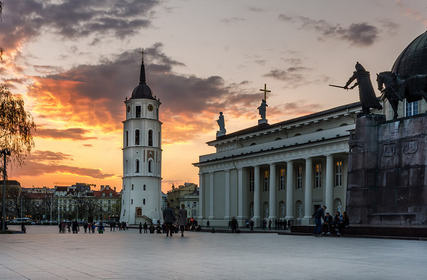Vilnius, Lithuania’s capital, is located in the southwest of the country at the confluence of the Neris and Vilnia rivers.
Often overlooked as a destination, Vilnius will break any stereotypes of what to expect from Lithuania’s largest city.
Visitors will not be disappointed with an unbeatable choice of restaurants that won’t break your bank balance, beautiful churches and monuments and desirable souvenirs such as ceramics and amber jewellery.
What to see
Vilnius has a compact city centre that is walkable, and the UNESO World Heritage listed Old Town has many pedestrianized areas not accessible to car or public transport so there are plenty of opportunities for exploring.
Don’t miss the iconic Šv. Onos Bažnyčia (St Anne’s Church) in the Old Town. This 14th century church is a stunning example of Brick Gothic architecture, and the façade design is meant to replicate the Lithuanian coat of arms. Even Napoléon commented on how lovely the church was in the 19th century that he wanted to transport it back to Paris.
A must see place to visit is the harrowing Genocido Aukų Muziejus (KGB Museum) that is housed in the former headquarters of the KGB and Gestapo. The exhibits show the brutality of life under Communist rule during a 50-year Soviet occupation with tours of the execution rooms, torture rooms and displays of items from mass graves. Check opening hours prior to visiting as they are closed on Monday and Tuesday.
Imagine life in Vilnius back in the 16th century, as you walk through the Gate of Dawn. This is the only surviving gate of nine city gates that were built between 1503 and 1522, and is an important religious and historical element to the city. It is well known for the painting of the Blessed Virgin Mary Mother of Mercy in the chapel that is thought to bestow miracles on followers.
What to do
Stop by Cathedral Square at the base of Gediminas Hill in the Old Town where you can visit two of Vilnius’ most important buildings, the Arkikatedra Bazilika (Vilnius Cathedral) and the Palace of the Grand Dukes.
The Vilnius Cathedral is a national symbol of the Lithuanian conversion from paganism to Christianity. Admire the bellfry, exterior neoclassical columns and impressive interior with artworks and frescoes. Join a tour of the catacombs where many famous Lithuanians are laid to rest including Vytautas the Great, the Grand Duke of Lithuania.
The Palace of the Grand Dukes is a reconstruction of the original Renaissance palace from the 16th century that was destroyed and torn down during Russian occupation. The palace was previously the political heart for the rulers of the Grand Duchy of Lithuania, and today houses a museum with archaeological finds and replica furniture from different eras.
After sightseeing at Cathedral Square, head to restaurant Neringa (Gedimino ave. 23) with traditional food like chicken Kiev and an interior unchanged over the decades that time stamps what it was like to dine here in the 1950’s.
Nearby things to see and do
Trakai Castle and History Museum is located 28 kilometers west of Vilnius built on an island in Lake Galvė. This fairytale castle is best reached by private car as the train station in Trakai is located another 20 minute walk. Take your camera for photo perfect angles of the rust red castle turrets and try your hand at using a crossbow.
Drive 100 kilometers west from Vilnius to Lithuania’s second-largest city, Kaunas. There are many historical, natural and off-beat attractions here – visit the Kaunas Botanical Gardens, the unusual Devils Museum, ride a funicular or if you have your own car head to the Open Air Museum a short drive from Kaunas that details the traditions of peasants and townspeople from different regions through farm buildings and craft workshops.














